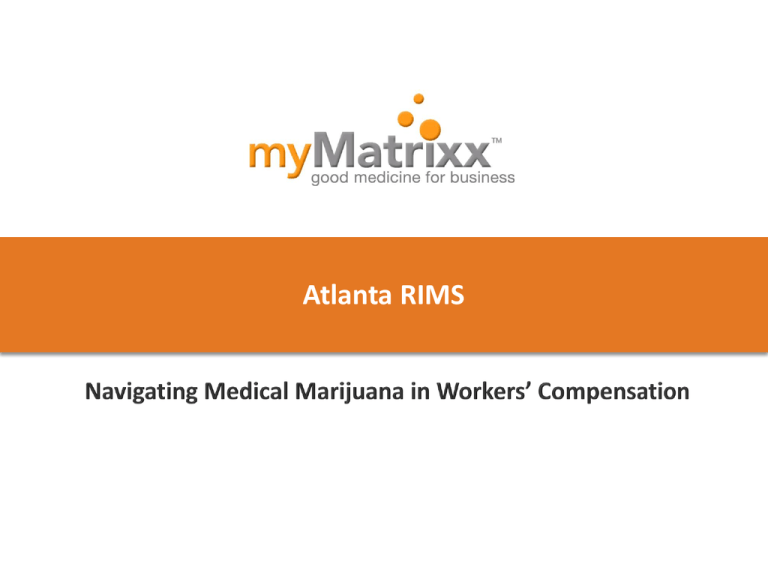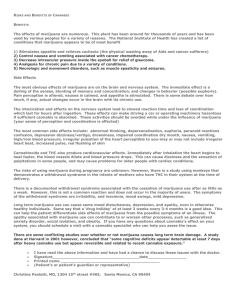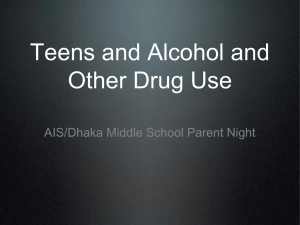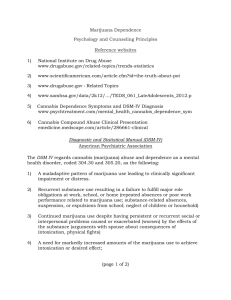
Atlanta RIMS
Agenda
Background on Marijuana
Federal and State Laws
Marijuana as a Medicine
Implications for Employers
Implications for Workers' Compensation
Best Practices
Conclusion
2
© 2012 myMatrixx. All rights reserved.
Background on Marijuana
• Leaves and buds of the plant Cannabis sativa
• Primary psychoactive ingredient: Tetrahydrocannabinol (THC)
• Contemporary uses: recreational, religious &
spiritual rites, and medicine
• 16.7 million Americans ≥ 12 used marijuana once in the month prior to
being surveyed (National Survey on Drug Use and Health 2009)
• The world’s most popular illicit drug (United Nations Office on Drugs and
Crime: World Drug Report 2010)
3
© 2012 myMatrixx. All rights reserved.
Federal Law: Controlled Substance Act (CSA)
• Title II of the Comprehensive Drug Abuse Prevention and Control Act of
1970
• Regulates the manufacture, importation, possession, use, and distribution
of certain substances
• Initially created five Schedules with defined qualifications
• DEA and FDA maintain scheduling
• Scheduling can change through legislative amendments and petitioning
• States can maintain a separate classification list that can conflict
with federal classifications (Oregon, Wisconsin, Iowa)
4
© 2012 myMatrixx. All Rights Reserved.
Federal Law: Controlled Substance Schedules
Schedule
Qualifications
I
High potential for abuse
No currently accepted medical use
Lack of accepted safety for use under medical supervision
II
High potential for abuse
Have currently accepted medical use
Abuse may lead to severe psychological or physical dependence
III
IV
Abuse potential less than CI, CII
Have currently accepted medical use
Abuse may lead to moderate or low physical dependence or high
psychological dependence
Abuse potential less than CIII
Have currently accepted medical use
Limited physical dependence or psychological dependence relative to CIII
V
Abuse potential less than CIII
Have currently accepted medical use
Limited physical dependence or psychological dependence relative to CIV
5
© 2012 myMatrixx. All Rights Reserved.
Federal Law: Marijuana
Marijuana is a Schedule I drug under the federal Controlled Substances Act
•
Makes possession, usage, purchase, sale, and/or cultivation of marijuana
illegal
•
May not be prescribed, administered, or dispensed
•
Other Schedule I drugs include:
•
Lysergic acid diethylamide (LSD)
•
Diacetylmorphine (Heroin)
•
Gamma Hydroxybutyric Acid (GHB)
•
MDMA (“ecstasy”)
•
Mescaline
6
© 2012 myMatrixx. All Rights Reserved.
State Law
In 1996 California passed Proposition 215, later renamed Compassionate Use Act.
• First law allowing patients to possess and cultivate marijuana for medical use.
Now legal in 17 states & District of Columbia
•
•
•
•
•
•
•
•
•
Alaska
Arizona
California
Colorado
Connecticut
DC
Delaware
Hawaii
Maine
•
•
•
•
•
•
•
•
•
Michigan
Montana
Nevada
New Jersey
New Mexico
Oregon
Rhode Island
Vermont
Washington
Similar legislation pending in 6 other states
• Arkansas
• New York
• Illinois
7
© 2012 myMatrixx. All rights reserved.
• Ohio
• Massachusetts
• Pennsylvania
State Law
Failed Medical Marijuana
Bills in 2012
Alabama
Idaho
Indiana
Iowa
Kansas
Maryland
Mississippi
New Hampshire
Oklahoma
Tennessee
West Virginia
Wisconsin
8
© 2012 myMatrixx. All rights reserved.
Pending Decriminalization
Bills
Arizona
Hawaii
Indiana
North Carolina
New Hampshire
New Jersey
New York
Rhode Island
Vermont
Oregon
Washington
Colorado
State Law
Colorado’s Amendment 64, a campaign to regulate marijuana like alcohol has
received public support from:
• The Colorado Democratic Party
• 56% of the Denver County Republican Assembly
• NAACP
• Members of the Colorado’s law enforcement community
• More than 300 Colorado physicians
• More than 100 college professors from across the nation
9
http://www.huffingtonpost.com/2012/10/24/colorados-marijuana-legal_n_2010123.html
© 2012 myMatrixx. All rights reserved.
Registration of Patients
States with Active Registry
State
Colorado
Oregon
Montana
Michigan
Hawaii
Rhode
Island
Arizona
New
Mexico
Maine
Nevada
Alaska
10 Vermont
Total Number
of Registrants
Registry not yet Active
(will be mandatory)
Per 1,000 of
Population
82,089
57,386
14,364
131,483
11,695
16.3
15.0
14.5
13.3
8.6
4,466
4.2
22,037
4,310
3.5
2.1
2,708
3,388
538
505
2.0
1.3
0.8
0.8
© 2012 myMatrixx. All rights reserved.
Connecticut
Delaware
District of Columbia
New Jersey
Voluntary Registration
California
Marijuana as a Medicine
Therapeutic Potential:
1) Relieving pain
2) Controlling nausea
3) Stimulating appetite
4) Decreasing ocular pressure
Cannabinoid-based medications:
1) Dronabinol (Marinol®)
2) Nabilone (Cesamet®)
3) Sativex®
11
© 2012 myMatrixx. All rights reserved.
Clinical Trials on Marijuana as a Medicine
Completed Studies
Impact to WC?
• Efficacy and Safety of Dronabinol Metered Dose Inhaler
(MDI) in Acute Treatment of Migraine Headache
Yes
• Effect of Dronabinol on Behavioral Therapy in
Fibromyalgia and Chronic Back Pain
Yes
• Effects of Cannabis Based Medicine in Patients With Pain
of Neurological Origin (inhaler)
Yes
• Sativex® for Pain Relief in Patients With Advanced
Malignancy
Yes
• Maintenance of Effect After Long-term Treatment With
Sativex® in Subjects With Symptoms of Spasticity Due to
Multiple Sclerosis
Yes
12
© 2012 myMatrixx. All rights reserved.
Clinical Trials on Marijuana as a Medicine
Recruiting Trials:
• Dronabinol Naltrexone Treatment for Opioid Dependence
• Efficacy Trial of Oral Tetrahydrocannabinol in Patients With Fibromyalgia
• Cannabis for Spasticity in Multiple Sclerosis (smoked cannabis)
• Effect of Cannabinoids on Spasticity and Neuropathic Pain in Spinal Cord
Injured Persons (Nabilone)
13
© 2012 myMatrixx. All rights reserved.
Clinical Trials on Marijuana as a Medicine
Unknown Status:
• Evaluate the Efficacy of Dronabinol (Marinol) as Add-On
Therapy for Patients on Opioids for Chronic Pain
• Efficacy Trial of Oral Tetrahydrocannabinol in Patients With
Fibromyalgia
• Effect of Delta-9-Tetrahydrocannabinol on the Prevention of
Chronic Pain in Patients With Acute CRPS (ETIC-Study)
14
© 2012 myMatrixx. All rights reserved.
Medical Use of Smoked Marijuana
Appetite loss from wasting syndrome (Cachexia):
• Stimulates appetite in patients with AIDS
• Increases caloric intake and causes weight gain
• Cachexia also experienced in cancer, heart failure, severe trauma, and
burns
Nausea and Vomiting:
• Modestly effective
• Poorly tolerated by cancer patients
• Unique antiemetic mechanism; may be useful as adjunctive therapy
Multiple Sclerosis:
• THC reduces tremor and spasticity
• Reduces urge incontinence
• Effective when smoked or taken orally
15
© 2012 myMatrixx. All Rights Reserved.
Medical Use of Smoked Marijuana
Glaucoma:
• Reduces intraocular pressure
• Decreases blood flow to optic nerve
• Unknown if visual function is improved
Pain:
• Animal studies suggest mild to moderate
analgesic properties
• Modestly effective for chronic pain (including neuropathic)
• Relatively high risk of adverse events (NNH= 5 to 8 for altered
perception and altered cognitive function)
16
© 2012 myMatrixx. All Rights Reserved.
State Sanctioned Indications
Conditions common to most states:
• Chronic pain (ill-defined origin)
• AIDS/HIV
• Cancer
• Multiple Sclerosis
• Persistent muscle spasms (not limited to MS)
• Epilepsy
• Crohn’s disease
Other conditions: subject to approval by Dept of Health
Delaware: “chronic pain; if the condition has not responded to previously prescribed
medications”
District of Columbia: “For which there is scientific evidence that the use of medical
marijuana is likely to be significantly less addictive than the ordinary medical treatment
for that condition”
California: "deemed appropriate and has been recommended by a physician”
17
© 2012 myMatrixx. All Rights Reserved.
Medical Risks of Marijuana Use
Physiological Risk:
• Acute use: diminished psychomotor performance, dry mouth
(xerostomia), reddening of the eyes
• Chronic use:
Effects from Smoking
• Abnormalities of respiratory
tract cell lining
• ↑risk of cancer, lung
damage and poor pregnancy
outcomes
18
© 2012 myMatrixx. All Rights Reserved.
Effects from THC
• Cognitive impairment
• Apathy
• Psychic decline
• Sexual dysfunction
• Abnormal menstruation
Marijuana Effects on Workplace Motivation
Does smoking cannabis affect work commitment?
Christen Hyggen. Addiction. Volume 107, Issue 7, pages 1309-1315, July 2012
Setting: The panel survey was a nation-wide study set in Norway
Participants: 1997 respondents born between 1965 and 1968: separated into
groups of “abstaining”, “exposed”, “experimenters”, and “involved”
Findings:
• The level of work commitment was associated with involvement with cannabis
• “involved” group and “experimented” reported less work commitment
compared to the “abstainer” group
• “experimented” group converged towards the “abstainers “and “exposed” as
they grew older
• “involved” reported decreasing work commitment into adulthood
• Factors related socio-economic background, education, labor market
experiences, mental health and family characteristics were factored in
19
© 2012 myMatrixx. All Rights Reserved.
Medical Risks of Marijuana Use
Abuse, Dependence , & Addiction:
• Less significant than that associated with alcohol, nicotine, and others
controlled drugs
• Risk factors: mental illness, history of substance abuse, younger age
• Anti-social personality and conduct disorder are closely associated with
abuse
• 10% of regular marijuana users become addicted
Withdrawal:
• Mild and transient
• Symptoms: restlessness, irritability, mild agitation, insomnia, sleep
disturbance, nausea, and cramping.
20
© 2012 myMatrixx. All Rights Reserved.
Medical Risks of Marijuana Use
Substance Abuse and Mental Health Services
Administration 2009:
• 120 million Emergency Dept. visits
• 4.5 million drug related
• 2.1 million drug misuse or abuse
• 1, 079, 683 (52%) pharmaceuticals
• 973, 591 (47%) illicit drugs
• 376, 467 (39%) marijuana
21
© 2012 myMatrixx. All Rights Reserved.
Source: Drug Abuse Warning Network, 2009.
Medical Marijuana: Implications for WC
Questions:
Issue for employers:
• What accommodations should employers make?
Issues for Payers:
• How should a recommendation (“prescription”) for MM be handled?
• Where should MM be placed within a pain management treatment plan?
• How can we best prepare for the emergence of MM during the
administration of a claim within the scope of IW treatment?
22
© 2012 myMatrixx. All Rights Reserved.
Issues for Employers
What accommodations should employers make?
• Private sector: employers can accommodate unless the company
receives federal contracts (Drug-Free Workplace Act of 1988)
• DOT guidelines: prohibit MM for transportation workers
• OSHA: employers have general duty to provide safe work
environment
• 2008 California Supreme Court case: Ross v. Ragingwire
Telecommunications, Inc> drug testing is legal and not discriminatory
23
© 2012 myMatrixx. All rights reserved.
Issues for Employers
What accommodations should employers make?
• Washington State Human Rights Commission: “will decline to
investigate any claims of discrimination involving MM
• CO, HI, MI, MT, NJ, NM, VT: only on-the-job
consumption/impairment is grounds for termination
• Battle Creek, Mich: Walmart terminates cancer patient for using
MM
• RI, ME: “no school, employer or landlord may refuse to enroll,
employ or lease to or otherwise penalize a person solely for his or
her status as a card holder” § 21-28.6-4
24
© 2012 myMatrixx. All rights reserved.
Issues for Payers
How should a prescription for MM be handled?
No prescriptions for medical marijuana should be covered:
• Not FDA approved
• Not covered by any private or public health plans
• Violation of federal law
25
© 2012 myMatrixx. All rights reserved.
Issues for Payers
How should marijuana be addressed within a pain management
treatment plan?
• No evidence-based place in therapy
• Counterproductive to goals of therapy
• Indicative of aberrant behavior
26
© 2012 myMatrixx. All Rights Reserved.
Marijuana and Opioid-related Aberrant Behavior
Medical cannabis and chronic opioid therapy.
• National Survey on Drug Use and Health (NSDUH): positive association
between past year cannabis use and past year nonmedical use of opioids
• Association is stronger in persons 50 and older
• Prevalence of past year nonmedical use of opioids was 10.7%, compared to
1.1% in cannabis users vs. non-users
• Prevalence of cannabis use multiple times higher among patients in nearly
all age groups
• Significant associations between cannabis use and a spectrum of aberrant
behaviors - opioid abuse and diversion, use of illicit substances and nonprescribed controlled substances, doctor shopping and opioid trafficking.
27
© 2012 myMatrixx. All Rights Reserved.
Reisfield GM.
J Pain Palliat Care Pharmacother. 2010 Dec;24(4):356-61.
Marijuana and Opioid-related Aberrant Behavior
Marijuana correlates with use of other drugs in a pain patient population.
• 21,746 urine specimens were obtained from chronic pain patients
• 13.0% incidence of patients positive for THC
• 4.6% positive for cocaine
• 1.07% positive for methamphetamine
• Conclusion: that there was a correlation between marijuana use and the use of
other illicit drugs
• The odds ratio was > 3.7 for other illicit drug use
28
© 2012 myMatrixx. All Rights Reserved.
Pesce A, West C, Rosenthal M, et al.
Pain Physician. 2010;13:283–287.
Best Practices
Proactive Approach
• Establish an authorization policy for MM
• Baseline UDS
• Insist on opioid contract
• Determine the physician’s policy on marijuana
Utilize advanced technologies to evaluate appropriateness of therapy
• Alert, Review, Manage® – analyze claimant data for adverse trends
• myRisk Predictor™ - assessment tool to identify injured workers who are at
high risk for potential abuse and misuse of prescription medications.
Communication between PBM and physicians
• Targeted intervention
• Detailed Drug Regimen review
Urine Drug Screening (UDS)
29
© 2012 myMatrixx. All Rights Reserved.
Questions?
30
© 2012 myMatrixx. All Rights Reserved.
Thank You
www.mymatrixx.com


![[H1]Researching Society with MicroCase Online](http://s3.studylib.net/store/data/007737973_2-9d35b9e42208c660471ccaa373bd3b78-300x300.png)






